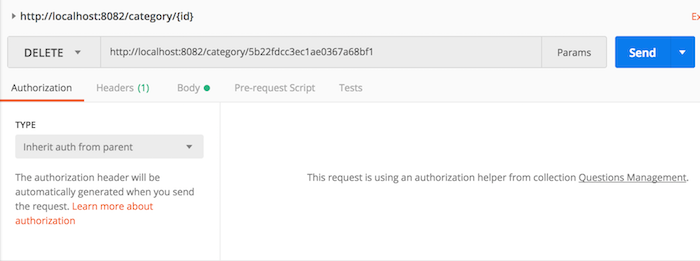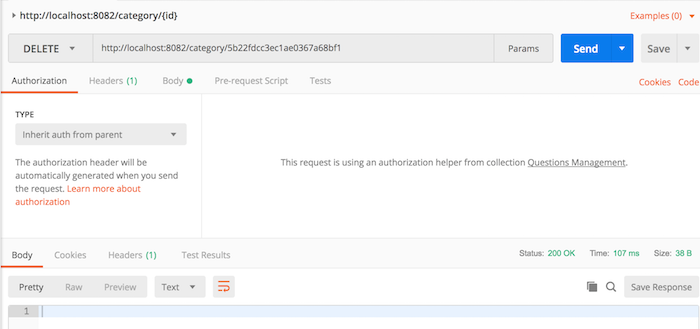Xem toàn bộ series bài viết hướng dẫn xây dựng ứng dụng Questions Management tại đây.
Trong bài viết trước, chúng ta đã chuẩn bị tất cả các thông tin, cấu hình cần thiết để có thể xây dựng API xoá category như: một đối tượng document Category chứa thông tin của một category, một CategoryRepository để thao tác với MongoDB, một CategoryController định nghĩa các API của Core Category Service sẽ bắt đầu với “/category” và thông tin về kết nối đến MongoDB server được cấu hình trong tập tin application.properties. Bây giờ, chúng ta sẽ tiến hành xây dựng API để xoá category các bạn nhé!
Để xây dựng API xoá category, mình sẽ thêm mới một method để expose một DELETE request “{id}” với id là id của category mà chúng ta cần xoá:
|
1 2 3 |
@DeleteMapping("/{id}") public Mono<ResponseEntity<Void>> deleteCategory(@PathVariable(value = "id") String categoryId) { } |
Các bạn xem thêm bài viết Binding biến trong request URI với tham số của phương thức sử dụng annotation @PathVariable trong Spring MVC để hiểu rõ hơn về biến id trong request URL trên các bạn nhé!
Các bước để xoá một category bao gồm:
Đầu tiên, chúng ta cần phải kiểm tra là category mà chúng ta muốn xoá có tồn tại hay không dựa vào id mà người dùng truyền vào.
Spring Data MongoDB Reactive đã hỗ trợ cho chúng ta phương thức để tìm kiếm theo id nên chúng ta chỉ cần gọi để sử dụng mà thôi.
|
1 |
categoryRepository.findById(categoryId); |
Trong trường hợp category này tồn tại, chúng ta sẽ delete nó và trả về HTTP status code là 200 OK.
|
1 2 3 |
categoryRepository.findById(categoryId) .flatMap(existingCategory -> categoryRepository.delete(existingCategory) .then(Mono.just(new ResponseEntity<Void>(HttpStatus.OK)))) |
Còn nếu nó không tồn tại thì trả về kết quả HTTP status code là 404 Not Found.
|
1 2 3 4 |
return categoryRepository.findById(categoryId) .flatMap(existingCategory -> categoryRepository.delete(existingCategory) .then(Mono.just(new ResponseEntity<Void>(HttpStatus.OK)))) .defaultIfEmpty(new ResponseEntity<>(HttpStatus.NOT_FOUND)); |
Toàn bộ nội dung của phương thức deleteCategory() lúc này sẽ như sau:
|
1 2 3 4 5 6 7 |
@DeleteMapping("/{id}") public Mono<ResponseEntity<Void>> deleteCategory(@PathVariable(value = "id") String categoryId) { return categoryRepository.findById(categoryId) .flatMap(existingCategory -> categoryRepository.delete(existingCategory) .then(Mono.just(new ResponseEntity<Void>(HttpStatus.OK)))) .defaultIfEmpty(new ResponseEntity<>(HttpStatus.NOT_FOUND)); } |
Đến đây thì chúng ta đã hoàn thành việc xây dựng API xoá category cho Core Category Service, hãy test thử xem sao nhé các bạn.
Giả sử hiện tại trong database mình đang có những category sau:

thì khi mình request để xoá category với id là 5b22fdcc3ec1ae0367a68bf1:

Kết quả sẽ là:

Phần cuối cùng mà chúng ta cần làm là thêm mới Unit Test cho code mà chúng ta vừa thêm vào.
Trong bài viết trước, mình đã tạo mới class test cho CategoryController tên là CategoryControllerTest, đối tượng Mock cho CategoryRepository và inject đối tượng Mock này vào class CategoryController:
|
1 2 3 4 5 6 7 8 9 10 11 12 13 14 15 |
package com.huongdanjava.categoryservice; import org.mockito.InjectMocks; import org.mockito.Mock; import com.huongdanjava.categoryservice.repository.CategoryRepository; public class CategoryControllerTest { @Mock private CategoryRepository categoryRepository; @InjectMocks private CategoryController categoryController; } |
Khởi tạo mock mỗi khi chạy một test case:
|
1 2 3 4 |
@Before public void init() { MockitoAnnotations.initMocks(this); } |
Giờ mình sẽ thêm mới hai phương thức để test cho phương thức của deleteCategory() của class CategoryController như sau:
Một phương thức để test cho trường hợp có category dựa vào id truyền vào:
|
1 2 3 4 5 6 7 8 9 10 11 12 13 14 15 16 17 18 19 20 21 22 |
@Test public void testDeleteExistingCategory() { // Create category document to return when using findById Category category = new Category(); category.setId("123"); category.setCode("ABC"); category.setName("ZXC"); // Mock findById() method of CategoryRepository to return above category when(categoryRepository.findById("123")).thenReturn(Mono.just(category)); // Mock delete() method of CategoryRepository when(categoryRepository.delete(category)).thenReturn(Mono.empty()); // Call method Mono<ResponseEntity<Void>> delete = categoryController.deleteCategory("123"); ResponseEntity<Void> responseEntity = delete.block(); // Assertions assertEquals(HttpStatus.OK, responseEntity.getStatusCode()); } |
Một phương thức để test cho trường hợp không có category dựa vào id truyền vào:
|
1 2 3 4 5 6 7 8 9 10 11 12 13 |
@Test public void testDeleteNoExistingCategory() { // Mock findById() method of CategoryRepository to return an empty Mono when(categoryRepository.findById("123")).thenReturn(Mono.empty()); // Call method Mono<ResponseEntity<Void>> delete = categoryController.deleteCategory("123"); ResponseEntity<Void> responseEntity = delete.block(); // Assertions assertEquals(HttpStatus.NOT_FOUND, responseEntity.getStatusCode()); } |
Chạy “Maven test” trong STS hoặc “mvn test” với Apache Maven, các bạn sẽ không lỗi nào cả.



Sơn
Chào a, a cho e hỏi tại sao khi e remove thì nó báo lỗi “cannot remove from a capped collection”, e lên google search thì người ta bảo là không thể sử dụng remove cho capped collection. Thanks a.
Khanh Nguyen
Đúng rồi em, capped collection của MongoDB không cho mình remove từng document một. Chỉ nên sử dụng capped collection những lúc cần thiết thôi nhé!